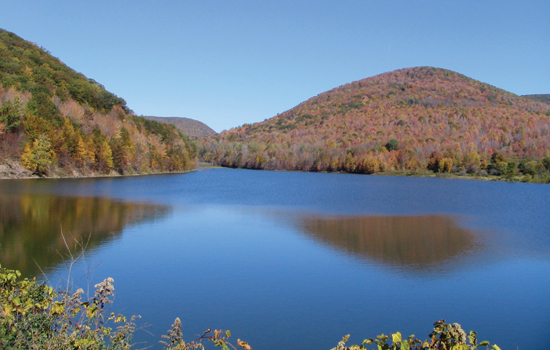RIT study maps environmental controversy over gas drilling in Catskills
Divided communities await New York state action
The Cannonsville Reservoir in Delaware County supplies most of the drinking water for New York City. The reservoir is one of several area watersheds that activists have argued will be harmed by gas drilling in the Catskills.
New research indicates that environmental media campaigns to stop gas drilling in the Catskills of New York state, while highly publicized, so far have had uncertain impact on stopping plans for drilling in the region’s Marcellus Shale. The results provide insights into the potential impact of news reports to affect policy change.
Diane Hope, the Kern Professor of Communication at RIT, studied the change in news reports, government actions and efforts of a host of environmental and community groups related to the decision to open up the Delaware River Watershed in the Catskills to significant horizontal gas drilling.
The area includes New York City drinking water reservoirs, and significant debate has arisen over the public actions that should be taken to access the natural gas deposits, while still protecting fresh water resources and overall public health.
Hope found that in a little over a year, news reports that initially focused on the economic benefits of gas drilling changed to focus on the environmental and health risks, including the use of numerous toxic and carcinogenic compounds in the hydraulic fracturing process of gas drilling, which makes containment, transportation and storage a serious concern for local residents.
Hope says that the changing news focus did lead New York state to hold public hearings to review drilling policies. Yet plans for numerous wells continue and the new government regulations will not be announced until sometime this summer.
“When looking at the changing media focus, it would seem that efforts to raise awareness about the negative impacts of drilling have been a success,” notes Hope.
“Currently there is a lull in drilling applications due primarily to the recession and falling prices for natural gas. However, New York state is continuing to finalize regulations to allow drilling in the region and numerous permits and proposals to drill are now working their way through the authorization process. Therefore, the actual impact of public action is so far unknown.”
Hope will present her findings at the 2009 National Conference on Communication and the Environment in June.
“There is a tendency to deem highly public environmental movements that receive a great deal of media coverage as successful,” says Hope. “But a closer study of the actual impact these actions have on the public policies they seek to change needs to be undertaken. This study will provide greater insights on the impact of media coverage and assist community and political activists in improving efforts to affect change.”













